|

songs | interviews | photos | tours | boots | press releases | timeline
Time Out (New York) (US)
May 8-15, 1996
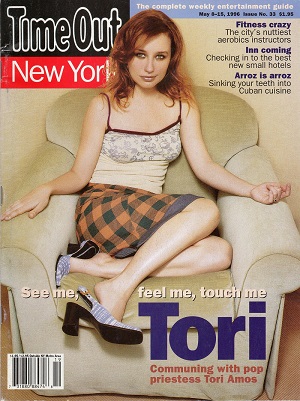
Who's Tori Now?
Minister's daughter, New age fruitcake or piano-humping, bad girl?
Tori Amos is all of these things, and more.
By Cathay Che
Photographed by Troy Word
It's Easter Sunday and the remnants of the morning's parade have caused a traffic jam in midtown. There's a perfect view of the chaos from Tori Amos's Four Seasons suite. Makeup artist Kevyn Aucoin is doing a touch-up on the acoustic pop diva, who is dressed head to toe in candy colored pastels (even her signature auburn hair seems a shade more strawberry blond). Amos flew in from London last night, having just completed 30 concert dates in Europe. Her photo shoot and lunch with Tony is the first of 14 bookings she has today, all part of the furious promotion surrounding the singer-songwriter's latest album, Boys for Pele, and her third world tour. Over the next year, she will perform more than 150 full-length shows.
"I'm 32 now; I'll be 33 this summer," she says. "To tell you the truth my body is starting to hurt. I've been playing for 30 years and there's no way around it. But knowing the turtle's race is the only way to keep pace. And I have fantastic people around me." Amos refers to her Pele crew, headed by her beloved tour manager of 5 years, John Witherspoon, and a support team that includes her best friend masseuse, a gourmet chef who specializes in her favorite Asian cuisine, and stylist Karen Binns.
All the same, Amos says of her image, "people shouldn't study too hard. My pictures are concepts for magazines. You know, there's a photographer, maybe a gorgeous Jamaican hairdresser -- Oh yes you can touch my hair -- or an artist like Kevyn who paints your face. But it's just a group of people getting together and playing. The live show is much more real, it's where everything is cooking for me, it's my strength, it's where I'm most comfortable. I love playing for people, but if there are no people, I'll just sit around and watch reruns of AbFab."
Although she's been described by more than one journalist as a flaky unicorn or fairy loving New Age girl (or even better, as she reminds me, "a shivering waif in the forest"), Amos's good humored whimsy strikes me today as an act of resistance. In the face of a daunting schedule and industry executives in severe black suits on cell phones, she is the eye of the storm.
Amos makes polite but firm requests, remembers everyone's name and thanks people who leave with a kiss on the cheek. These reminants of a good-ministers-daughter behavior are the backdrop for her thoughtful, heartfelt revelations and mischievous, free-associating banter. She's a woman who has spent most of her life thinking and feeling in music and developing her own language.
Like the artist to whom she is most often compared -- Kate Bush -- Amos was a child prodigy with humble roots. "Actually, I was a freak child," she muses. When she was two and a half, her Scottish father and part-Cherokee mother were shocked to discover that Amos could play the piano by ear.
She started composing at four, and at five she was packed off to the Prestigious Peabody Conservatory in Baltimore. Unfortunately, Amos was expelled at age 11 because she preferred to play her own compositions over the classics. After that, Amos's dad, a Methodist preacher, found an unusual showcase for his daughter's talents: the gay bars of Washington, D.C. "Gay bars gave me a chance before anyone," she declares. "I started at 13. My father chaperoned me, and since D.C. isn't a state, the (child labor) laws were more relaxed. I was kind of a tomboy-I had chops. As a musician, I could really hang, and there were very few woman musicians with the chops to hang: there have been a lot of good women writers but no players. Playing the 'Bosey' is like being a Formula One driver -- it gave me a surge of blood. But when I stepped out from behind the instrument, I felt like a blushing idiot. I was so confident as a musician, but so unconfident as a girl."
Throughout her teens and early twenties, Amos claims that the gay men she met in the bars and bonded with her were her "fairy godmothers," helping her develop social graces to match her natural skills as a performer. Now gay men are among Amos's loyal and sizable following, which also includes large numbers of recovering Christians, teen punks, sexual abuse survivors, Internet geeks, British comic book enthusiasts and sentimental grannies.
"Tori Amos has canceled tonight," jokes a Tori devotee parked in the audience of Amos's MTV Unplugged special, "but we do have Gene Simmons."
It's a few days later, and this intimate preview of her Pele stage show was supposed to have begun taping more than an hour ago. Just for Amos, the Brooklyn Academy of Music's Majestic Theater has been decorated with pink cloud backdrops and starry-night projections -- as unimaginative as the African print theme MTV did for the Seal the week before. The stage is set with Amos's standard black Bosendorfer piano facing her new instrument, a harpsicord. A modest square bench sits between the keyboards, indicating that she will be quick-change playing between the two. Amos will also be sharing the stage with guitarist, Steven Caton, who was part of her band when she cut her first album in 1985, a failed wanna-be metal-chick affair entitled Y Kant Tori Read, now a rare collectors item.
When Amos finally appears, wearing chic little black pants and some variation of a tube top, one voice cries out: "Tori I love you!" Taken aback by the intimacy of the room, she excaims: "Wow I can really see you all." It seems like a perfectly blase remark, but after five songs and three false starts, Amos pounds on the piano keys and says: "I gotta stop. I'm sucking so bad tonight. Let me take a break so I can find the girl who plays the piano."
There is a slight panic in the room as Amos slips off stage. The makeup artist and several other members of the Tori squad go sprinting after her. Later, Amos will explain: "With that made-for-TV light, everyone was lit -- it really threw me. It was like stooping in front of an open window in daylight and seeing that you're across from the bank. I asked for them to be dimmed. Also, my sound has to be in your belly, but there were concerns about creating feedback on tape. When I walked off stage, I was disgusted with myself. It's not hocus pocus, it's a skill -- you work off the energy of the audience. I had to address the fact that I wasn't able to let go. Like when it's not coming together in that high school play or you're at a wedding with blood on your dress. I had to have my moment."
Whatever Amos did to pull herself together that night, she returned to the stage and gave a great performance. Yes, the much-hyped way she plays her instrument, bluntly described by Sandman comics creator and pal Neil Gaiman as "fucking the piano," is powerfully sensual. Legs slightly spaced, Amos thrusts her hips, throws her back and grinds to the beat, occasionally flicking one arm behind her like a chicken leg or both arms in front of her palms flat, bracing herself against the face of the piano. But her style and presentation are just window dressing for her phenomenal talent - a powerful and flawlessly modulated voice fused with her quirky, sometimes dark but always fluid compositions. During her encore, worked-up fans shot out pleas for their favorite songs -- "Crucify!" "Winter!" "God!" Amos responds playfully, drawing out the tension: "You realize that some of you are going to be disappointed?" But she's wrong. Turning once again to the unexpected the song she goes with is not one of her own but a universal crowd-pleaser, a cover of Judy Garland's "Over the Rainbow."
original article
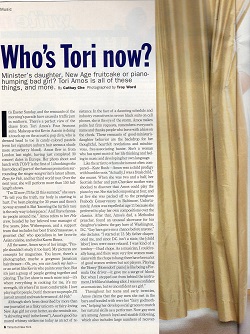 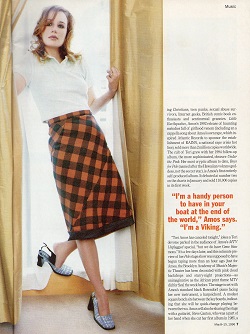
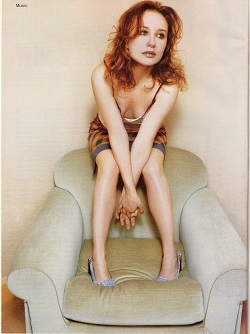 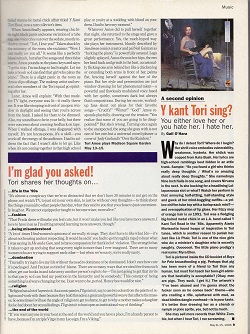
[scans by Sakre Heinze]
t o r i p h o r i a
tori amos digital archive
yessaid.com
|